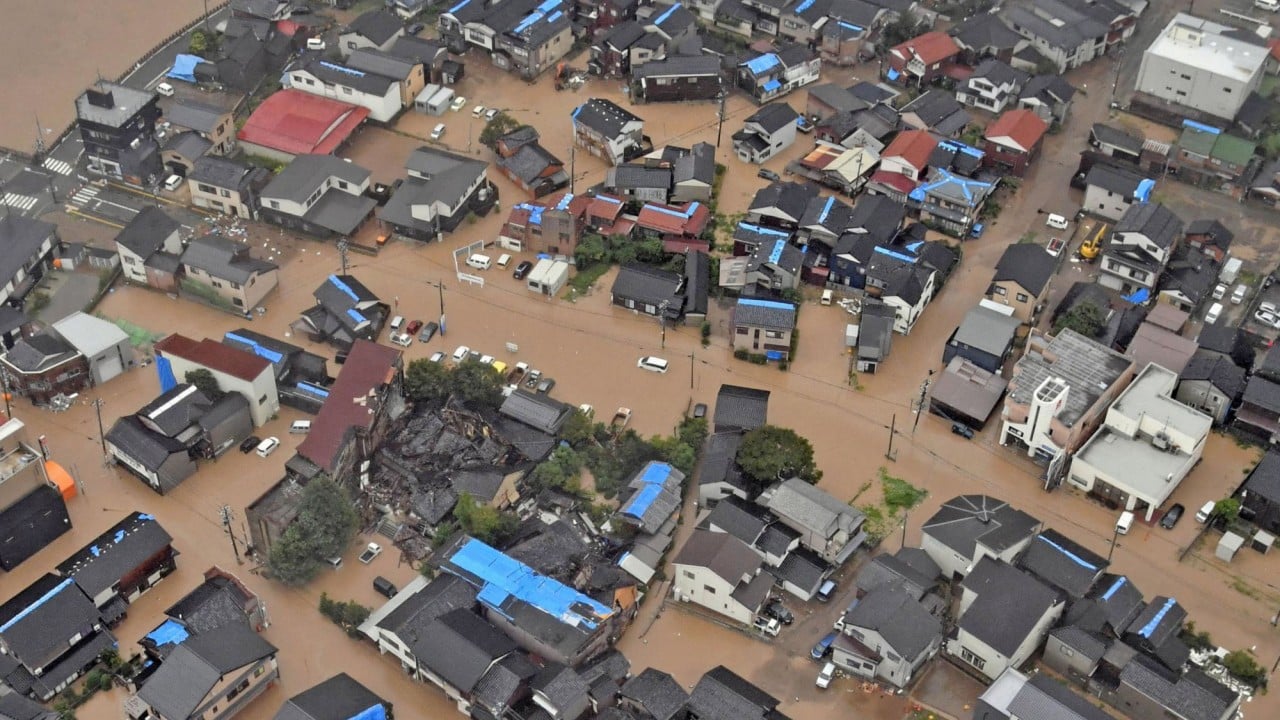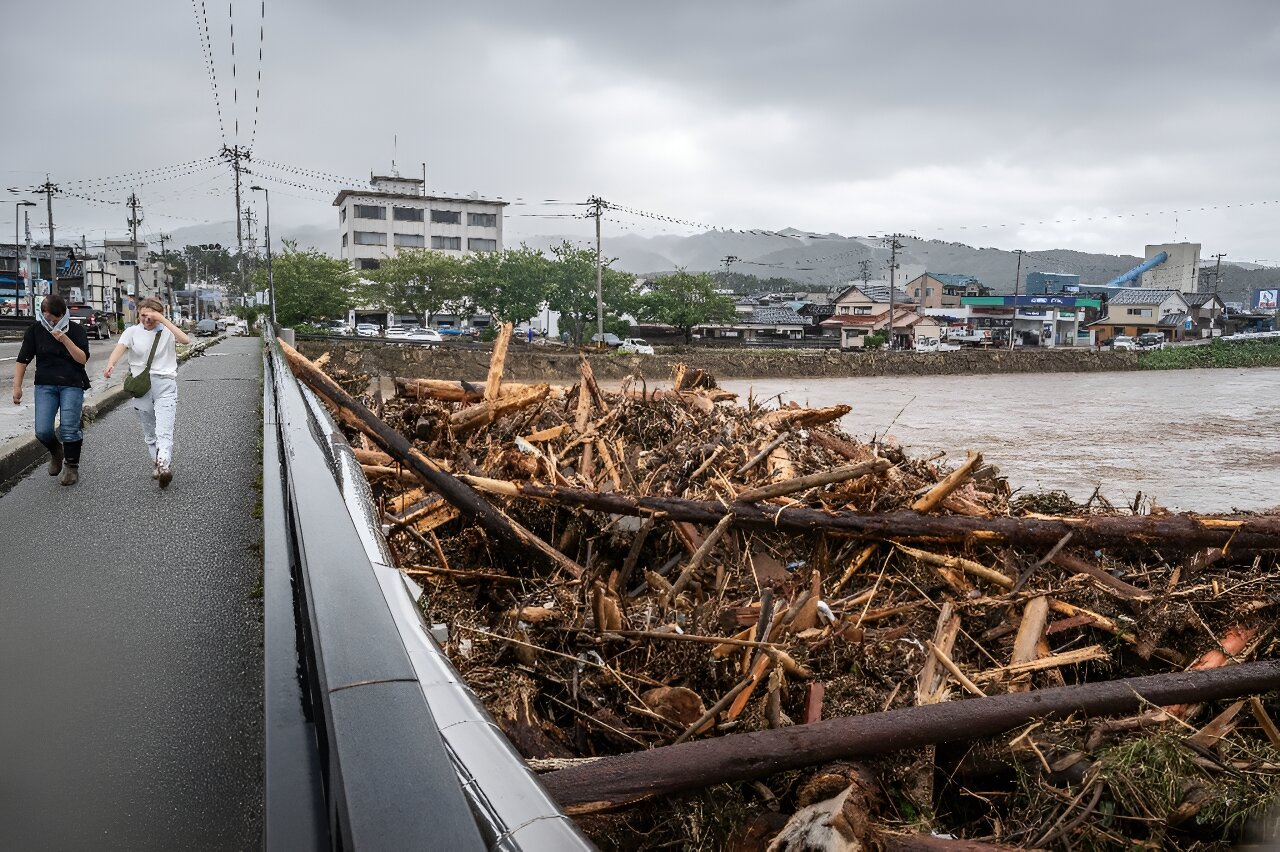Japan, a country known for its technological advancements and robust infrastructure, is no stranger to natural disasters. Earthquakes, typhoons, floods, and landslides are frequent and often devastating. Yet, the recent catastrophic floods and landslides in the Ishikawa Prefecture have underscored the persistent vulnerability of even the most developed nations to the unpredictable forces of nature. The heavy rainfall that pummeled the region not only claimed seven lives but also wreaked havoc on the infrastructure, displacing thousands and leaving many missing in the wake of overflowing rivers and landslides.
This disaster brings to light critical questions about Japan’s preparedness for natural calamities and the effectiveness of its disaster response systems. With climate change increasing the frequency and severity of extreme weather events, Japan’s current security strategies and disaster management capabilities will be tested in the years to come.

The Immediate Impact of the Floods and Landslides
The weekend of devastation in Ishikawa Prefecture began with relentless rainfall, which quickly transformed into widespread flooding and landslides. With around 20 inches (50.8 cm) of rain falling in just three days, rivers swelled beyond their banks, submerging entire neighborhoods and sweeping away buildings. According to Japan’s public broadcaster NHK, seven people were confirmed dead, and at least seven others were reported missing. Rescue teams continue to work tirelessly, scouring through the rubble and debris in the hope of finding survivors.
In Suzu, a town hit hard by the floods, one person died, and another was reported missing after being swept away by the torrent of water. In Wajima, two people were killed in a landslide that buried a construction site near the Nakaya tunnel, while 10 other individuals were rescued. Noto, another city in the affected region, reported one person missing and two others seriously injured after being caught in a landslide. As rescue workers race against time, families and communities wait anxiously for news of their missing loved ones.
The magnitude of the disaster extended beyond the loss of lives. The Land and Infrastructure Ministry reported that at least 16 rivers breached their banks, leading to widespread destruction of homes, roads, and other vital infrastructure. Approximately 1,350 residents sought shelter in community centers, school gymnasiums, and other temporary facilities. For many of these displaced families, the nightmare has not yet ended, as search-and-rescue efforts are still ongoing.

Japan’s Natural Disaster Risks
Japan’s geographic location makes it particularly susceptible to natural disasters. Situated on the Pacific Ring of Fire, the country regularly experiences earthquakes and volcanic eruptions. Additionally, its mountainous terrain makes it prone to landslides, and its position in the path of tropical cyclones results in frequent typhoons and flooding. While Japan has long been admired for its advanced engineering and disaster resilience strategies, events like the recent floods and landslides in Ishikawa highlight the country’s ongoing vulnerabilities.
Climate Change and the Increasing Frequency of Extreme Weather
The heavy rains that triggered the latest disaster in Ishikawa Prefecture were part of a broader pattern of extreme weather events exacerbated by climate change. Scientific consensus indicates that rising global temperatures are leading to more frequent and intense storms, as well as unpredictable rainfall patterns. For a country like Japan, which already faces annual typhoons and torrential rains, the impact of climate change is particularly concerning.
The flooding in Ishikawa is a stark reminder that even the most developed and disaster-prepared nations are not immune to the consequences of a warming planet. Japanese officials noted that approximately 20 inches of rain had fallen over three days, a volume far exceeding normal levels for the region. As climate change continues to intensify rainfall events, Japan will likely face more frequent and severe floods, necessitating a reevaluation of its disaster preparedness strategies.

The Role of Terrain and Infrastructure
Japan’s mountainous geography and dense population further exacerbate its vulnerability to landslides and floods. Many towns and cities, including those in Ishikawa Prefecture, are located near rivers and valleys, where rainfall accumulates rapidly, leading to flash floods and landslides. In the recent disaster, several buildings were swept away by overflowing rivers, while landslides buried homes and roads.
The country’s extensive infrastructure network, while advanced, is also subject to stress from natural disasters. In Ishikawa, multiple roads were rendered impassable due to the landslides, slowing rescue operations and preventing the delivery of essential supplies to affected areas. As floods and landslides become more frequent, it raises the question of whether Japan’s infrastructure, despite its reputation for resilience, is adequately prepared for the challenges of the future.
Earthquakes and Flood Management
Japan has a long history of dealing with natural disasters, and its expertise in earthquake preparedness is internationally renowned. The country has invested heavily in building earthquake-resistant infrastructure, early warning systems, and public education campaigns. However, the recent flooding in Ishikawa has highlighted that Japan’s approach to flood and landslide management may require further enhancement.
Flooding, in particular, presents unique challenges that differ from earthquake preparedness. Unlike earthquakes, which strike with little warning, floods can be forecasted to some extent through weather prediction models. However, even with advanced warning systems in place, mitigating the impact of floods requires robust infrastructure, well-planned evacuation strategies, and rapid response capabilities.
The current disaster comes at a time when Japan is still recovering from the effects of an earthquake that struck the same region in January, which left more than 200 people dead. The compounded effects of multiple natural disasters have stretched the country’s disaster management resources thin, highlighting the need for a more integrated approach to disaster preparedness that accounts for the increasingly unpredictable nature of extreme weather events.

Strengths and Areas for Improvement
Japan has long been regarded as a global leader in disaster preparedness and response, and its swift mobilization of emergency services in the wake of the Ishikawa floods is a testament to its capabilities. The Fire and Disaster Management Agency, along with local and regional authorities, quickly dispatched rescue teams to the affected areas. Helicopters, boats, and specialized equipment were deployed to search for missing individuals and assist with evacuations.
However, despite these efforts, the recent disaster has exposed areas where improvements are needed. One critical issue is the adequacy of evacuation protocols. Although approximately 1,350 people took shelter in designated evacuation centers, reports indicate that many residents did not receive timely alerts, and some were hesitant to evacuate due to concerns about COVID-19 and other health risks associated with crowded shelters.
Communication and Public Awareness
Effective communication during natural disasters is key to ensuring that the public can make informed decisions about evacuation and safety. Japan has invested heavily in early warning systems, including smartphone alerts, television broadcasts, and radio warnings. However, the floodwaters in Ishikawa rose rapidly, and some residents were caught off guard, particularly those in rural and remote areas with limited access to real-time information.
Improving communication channels, especially for vulnerable populations, should be a priority for future disaster response efforts. Additionally, increasing public awareness of the dangers of floods and landslides, and encouraging compliance with evacuation orders, will be critical in minimizing casualties in future events.
Infrastructure Resilience
Japan’s infrastructure has proven remarkably resilient to earthquakes, but floods and landslides present a different set of challenges. Riverbanks, drainage systems, and flood barriers are essential for controlling the flow of water during heavy rainfall. In Ishikawa, at least 16 rivers breached their banks, overwhelming local flood defenses and causing widespread damage.
Reevaluating the design and maintenance of flood control infrastructure will be important as Japan prepares for more frequent extreme weather events. Strengthening levees, improving drainage systems, and investing in early flood detection technologies can help mitigate the impact of future floods. Moreover, integrating natural solutions, such as wetland restoration and reforestation, into flood management strategies could help absorb excess rainfall and reduce the risk of flash floods.
Japan’s experience with natural disasters, including the recent floods and landslides in Ishikawa, offers valuable lessons for other nations grappling with the growing threat of extreme weather events. As climate change accelerates, countries around the world will need to develop comprehensive disaster preparedness strategies that account for the increasing frequency and severity of floods, storms, and other natural hazards.
Climate Adaptation and Disaster Risk Reduction
One of the key lessons from Japan’s experience is the importance of climate adaptation and disaster risk reduction. Governments must invest in infrastructure that can withstand extreme weather, from flood-resistant buildings to advanced drainage systems. Additionally, integrating climate adaptation strategies into urban planning can help reduce the vulnerability of communities to natural disasters.
Japan’s early warning systems and public education campaigns also serve as a model for other nations. By equipping citizens with the knowledge and tools to respond to disasters, countries can minimize the loss of life and property during extreme weather events.
As natural disasters become more frequent and severe, international collaboration will be crucial in building resilience to future crises. Japan’s expertise in disaster management and response is widely recognized, and the country has played a leading role in global efforts to improve disaster preparedness through organizations like the United Nations Office for Disaster Risk Reduction (UNDRR).
By sharing best practices and collaborating on disaster risk reduction initiatives, countries can enhance their collective ability to respond to the challenges posed by climate change. Japan’s experience with floods, earthquakes, and landslides can provide valuable insights for other nations facing similar threats, particularly in regions where infrastructure and disaster preparedness are still developing.

The devastating floods and landslides that struck Ishikawa Prefecture in Japan serve as a tragic reminder of the destructive power of natural disasters and the ongoing vulnerabilities faced by even the most developed nations. As Japan mourns the loss of life and begins the long process of recovery, the country must also reflect on how it can better prepare for future disasters in an era of accelerating climate change.
While Japan’s disaster response capabilities are among the most advanced in the world, the recent disaster has highlighted areas for improvement, particularly in terms of flood management, infrastructure resilience, and public awareness. As the global climate crisis continues to unfold, Japan and other nations must work together to build more resilient societies capable of withstanding the increasing threats posed by extreme weather events.
By investing in climate adaptation, improving disaster preparedness, and fostering international cooperation, Japan can continue to serve as a global leader in disaster resilience, offering hope and guidance to a world facing an uncertain future.



